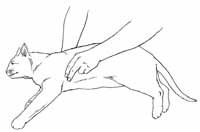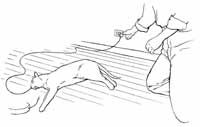Grown cats are seldom victims of electrical shock. But kittens are naturally curious and will chew almost anything, including electric cords, so they are more prone to being victims of electrical shock. If the insulation is punctured and the cat's mouth comes in contact with both wires, the cat will receive a shock and may be unable to release the cord.
You must disconnect the plug from the socket immediately, before touching the cat. If you touch the cat before disconnecting the cord, you can also be shocked.
Advertisement
Examine the cat carefully. Electrical shock can cause severe heart damage and fluid accumulation in the lungs. Strong shock can stop the cat's heart, and cardiopulmonary resuscitation (CPR) must be performed immediately to start the heart beating again.
You should also look for signs of shock, which include pale or white cat gums as well as rapid heartbeat and breathing.
Often, the cat's mouth will be burned from contact with the bare wires. This looks much more serious than it is, and will heal eventually if cleaned and treated properly.

If your cat has experienced an electrical shock, use the following cat care tips:
Step 1: If the cat still has the electrical cord in his or her mouth, do not touch. Remove the plug from the outlet.
Step 2: If the cat is breathing, proceed to Step 4. If the cat is not breathing, feel for a heartbeat by placing fingers about one inch behind the cat's elbow and in the center of its chest.
Step 3: If the cat's heart is not beating, perform CPR on the cat. If it is beating, perform artificial respiration.
Step 4: If the cat's mouth or lips are burned (bright red), swab them gently with 3 percent hydrogen peroxide. Do not use any other antiseptic.
Step 5: Transport the cat to the veterinarian immediately.
©Publications International, Ltd.
Advertisement
